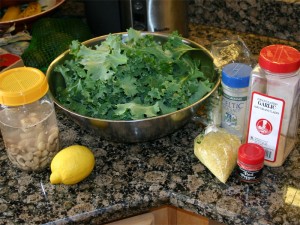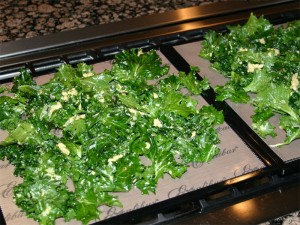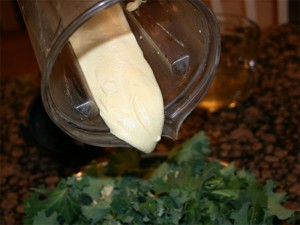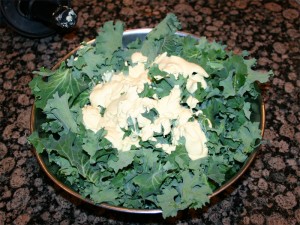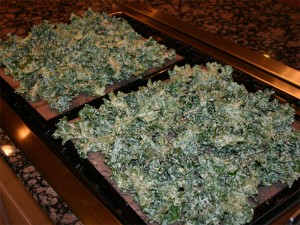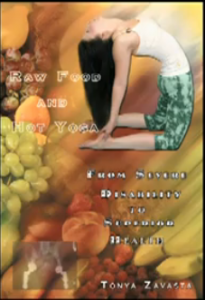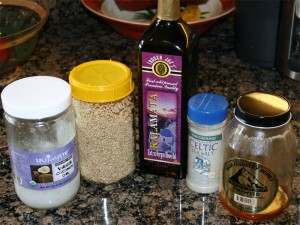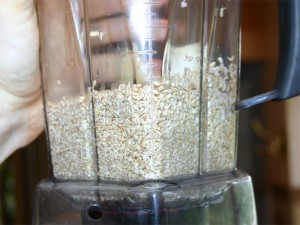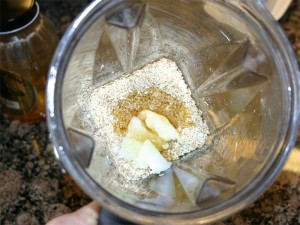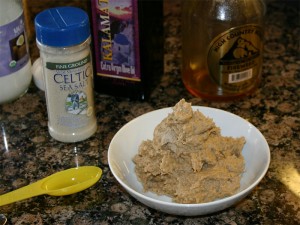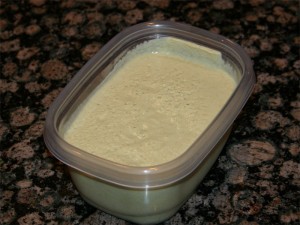Wow! That cashew nutritional yeast mixture is dynamite!
I’ve wanted to make kale chips for a while now but never really set my mind on it. Today, I set aside time to harvest some beautiful fresh kale from the garden and mix up the recipe that I found on Leiji Turune’s youtube site. Actually, it was under this video and I’ve copied it here.
Because this recipe takes a little preparation, I set a cup of cashews up to soak before heading to yoga this morning and figured they would be ready to go by the time I got home. Lucky for me, they were!
Here is what Leiji has to say about these amazing chips, my commentary will continue below:
Since I mention the yummy “cheesy” kale chips in this video, I thought I’d briefly share the recipe with everyone. Here it is:
Approximately (I never measure anything so these are just approximations)-
1.5- 2 cups soaked cashews (soak for about 1-4 hrs) Make sure to rinse them very well to remove enzyme inhibitors
6-8 tbsp nutritional yeast (not raw, but a source of vitamin B12- good for vegans) Add more or less depending on how “cheesy” you want it to taste.
About 1/4- 1/2 tsp celtic sea salt- I would recommend adding a little salt, tasting it, then adding more or less- You want the mixture to taste not too salty, or bland- just right for your tastebuds
1/2 small lemon juiced
Couple pinches of garlic (use other herbs if desired)
1/2 jalapeno pepper (optional)Process everything listed above in a food processor until smooth. You want to have 2 big bowls of kale already washed a broken into pieces (basically 2 big heads of kale.) Take the mixture with your hands and work in into the kale pieces- add more or less depending on how flavourful & “cheesy” you want it.
Spread kale on teflex trays and dehydrate for approx. 7-8 hrs at 105 degrees fahrenheit. Leave them in longer if you want them crispier.
Next, enjoy! They are very addictive and healthy! BTW, if you don’t have a dehydrator, that’s ok. You can still use the mixture as a dip/ dressing- do the same thing, where you work the mixture into the kale with your hands and then enjoy! Seriously delicious- such a simple, fast & tasty way to get in those very important dark leafy greens! YUMMEROO! 🙂
So, I set out to copy this recipe.
I gathered up everything that it called for and started dumping it in the blender. The thing I didn’t do was make two bowls full of kale, like the recipe calls for. I tried to cut down the recipe slightly by adding just one cup cashews to go with the one bowl of greens. That, was probably my mistake (the first time I attempted this recipe). When I got everything stacked in the blender, it barley looked like anything! After mixing it for a while, the tamper barely touched the mixture. It was kind of a pain to keep mixing.
When finished, it looked like peanut butter! Having seen other people massage it into the kale, I figured that would work. But, then again, it could be that THIS was my mistake! You see, the wet kale (that I’d just washed) just didn’t want to ‘bond’ with the cashew peanut butter. Next time, I will definitely add water to the mixture until it looks like a think salad dressing (which, is that I did the second time which continues below). I mean, it’s going in the dehydrator so a little more water really shouldn’t hurt.
But I plowed ahead with the cashew peanut butter and Wow, these chips still taste great!
The results from the first attempt didn’t sit right with me. The cashew peanut butter didn’t cover the kale smoothly so it was a bit hit-or-miss with flavor.
But I’ve messed things up worse the first time through. Fortunately, there was more kale in the garden (not anymore) so I got to stoke up the blender one more time to see if I could get the cashews to ‘run.’
I was a little surprised at how much water it took to get the cashews to flow in the blender. Just like the first time, the nuts immediately turn into peanut butter. But, I added spoonful after spoonful of water until it started to flow like a milkshake; a really thick one.
I also added a bit more red pepper to see if I could get it a bigger kick. You know me, bigger and better – until you over do it! Lol…
If you compare these trays to the first two, you’ll see that the chips are covered completely differently – evenly. I didn’t have problems with the mixture NOT sticking to the wet kale for it stuck to everything! That nutritional yeast is like GLUE. I sure hope it doesn’t digest like glue. That would be a bit nasty.
Both times, I made sure to wash my hands thoroughly before massaging the cashew ‘cheese’ into the kale so I could enjoy the best part – licking my hands clean afterwards. Eew you may say, but that nutritional yeast mixed with the soaked nuts just tastes amazing. If I get to making nut cheese, I would probably, most certainly, add nutritional yeast to the mixture. I can’t believe I’ve waited so long to make kale chips!
I’ve now got a number of lunch size bags of chips. You have to be kind of careful with these chips because the ‘cheese’ mixture doesn’t stick very hard. If you bump the bag hard, the flavor tends to get knocked off.
That’s ok, for what sticks is loaded with flavor! This really is a winner recipe! It’s not 100% raw, but it’s 100% yummy – like Leiji says!

